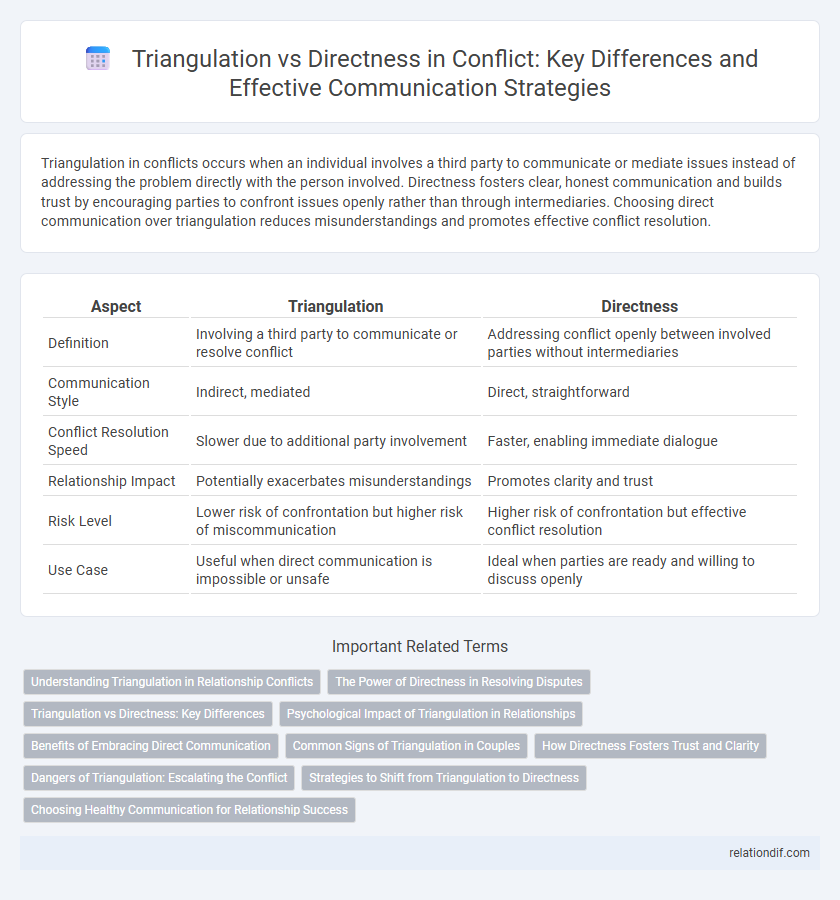Triangulation in conflicts occurs when an individual involves a third party to communicate or mediate issues instead of addressing the problem directly with the person involved. Directness fosters clear, honest communication and builds trust by encouraging parties to confront issues openly rather than through intermediaries. Choosing direct communication over triangulation reduces misunderstandings and promotes effective conflict resolution.
Table of Comparison
| Aspect | Triangulation | Directness |
|---|---|---|
| Definition | Involving a third party to communicate or resolve conflict | Addressing conflict openly between involved parties without intermediaries |
| Communication Style | Indirect, mediated | Direct, straightforward |
| Conflict Resolution Speed | Slower due to additional party involvement | Faster, enabling immediate dialogue |
| Relationship Impact | Potentially exacerbates misunderstandings | Promotes clarity and trust |
| Risk Level | Lower risk of confrontation but higher risk of miscommunication | Higher risk of confrontation but effective conflict resolution |
| Use Case | Useful when direct communication is impossible or unsafe | Ideal when parties are ready and willing to discuss openly |
Understanding Triangulation in Relationship Conflicts
Triangulation occurs when two parties in a relationship conflict involve a third person to reduce direct tension, often complicating communication and resolution. Directness promotes open dialogue between the original parties, fostering clarity and mutual understanding. Recognizing triangulation patterns helps individuals address conflicts more effectively by encouraging honest, face-to-face interactions.
The Power of Directness in Resolving Disputes
Direct communication fosters transparency and reduces misunderstandings, making it a powerful tool in conflict resolution. Triangulation often complicates disputes by introducing intermediaries who may distort messages or escalate tensions. Emphasizing directness encourages accountability and swift problem-solving, leading to more sustainable agreements.
Triangulation vs Directness: Key Differences
Triangulation in conflict involves indirect communication by using a third party to convey messages, often leading to misinterpretation and escalation. Directness emphasizes straightforward, face-to-face communication, fostering clarity and faster resolution. Understanding these key differences aids conflict management by promoting transparency and reducing misunderstandings.
Psychological Impact of Triangulation in Relationships
Triangulation in relationships creates psychological tension by fostering confusion, mistrust, and emotional instability among involved parties. It undermines direct communication, leading to increased anxiety and feelings of powerlessness as individuals struggle to understand conflicting messages. The resulting emotional distress often impairs relationship satisfaction and long-term mental health.
Benefits of Embracing Direct Communication
Embracing direct communication in conflict resolution enhances clarity by reducing misunderstandings and fosters trust through transparent dialogue between parties. It empowers individuals to address issues promptly, avoiding the complications and emotional strain associated with triangulation. This straightforward approach accelerates problem-solving and strengthens relationships by promoting accountability and mutual respect.
Common Signs of Triangulation in Couples
Common signs of triangulation in couples include involving a third party in conflicts to avoid direct communication, creating alliances that shift blame or responsibilities, and using intermediaries to express feelings instead of addressing issues face-to-face. This pattern often leads to miscommunication, increased mistrust, and unresolved conflicts, as direct dialogue is bypassed. Recognizing these behaviors helps couples foster transparency and healthier conflict resolution.
How Directness Fosters Trust and Clarity
Direct communication eliminates misunderstandings by promoting transparency and honesty, which are key to building trust in any conflict resolution. When parties address issues head-on without triangulating through third parties, clarity is enhanced and the risk of misinterpretation decreases. This straightforward approach encourages accountability and strengthens relationships by fostering mutual respect and open dialogue.
Dangers of Triangulation: Escalating the Conflict
Triangulation in conflict often intensifies tensions by involving third parties to relay messages, which distorts communication and fosters misunderstanding. This indirect approach can escalate disputes, as conflicting parties lose control over the narrative and emotional triggers amplify. Direct communication is essential to prevent the amplification of conflicts and promote resolution through transparency and accountability.
Strategies to Shift from Triangulation to Directness
To shift from triangulation to directness in conflict resolution, establish clear communication channels that encourage confronting issues with the involved parties rather than involving third parties. Implement training programs that develop assertiveness and emotional intelligence, fostering a culture where individuals feel safe to express concerns openly. Promote accountability by setting expectations for transparency and direct feedback, reducing the reliance on intermediaries and enhancing conflict resolution efficiency.
Choosing Healthy Communication for Relationship Success
Triangulation often complicates conflict resolution by involving third parties, which can distort messages and escalate misunderstandings. Choosing direct communication promotes clarity and emotional safety, fostering trust and mutual respect in relationships. Prioritizing honest, face-to-face dialogue empowers partners to address issues promptly and build stronger connections.
triangulation vs directness Infographic

 relationdif.com
relationdif.com